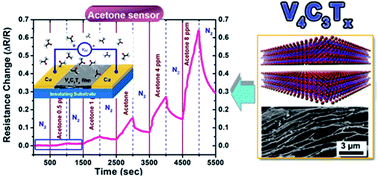A high-performance trace level acetone sensor using an indispensable V4C3Tx MXene†
Abstract
The development of a stringent sensor to detect low levels of acetone, yielding the potential for the point-of-care clinical diagnosis of diabetes, is still a great challenge but is urgently required. Most studies have focused on Ti3C2Tx, yet other types of MXenes with good performance are rare. Herein, an emerging kind of MXene, V4C3Tx, has been prepared from V4AlC3 via the selective etching of the Al layer using aqueous HF at room temperature (RT), and its performance as an acetone sensor is presented. A V4C3Tx based acetone sensor delivers good performance, as demonstrated by its low working temperature of 25 °C, low detection limit of 1 ppm (lower than the 1.8 ppm diabetes diagnosis threshold), and high selectivity towards acetone in a mixed gas of acetone and water vapor, hopefully showing promise for application in the much faster and earlier diagnosis of diabetes. V4C3Tx MXene is used for the first time in the field of acetone detection in this work, hopefully opening up a path for the investigation of applications of MXene in gas sensors, and such exciting findings distinguish V4C3Tx as a comparable material to the well-known Ti3C2Tx. In addition, we used DFT calculations to explore the mechanisms that result in the superior selectivity for acetone with respect to water vapor. Hopefully, the proposed mechanisms combining experimental results and theoretical study will shed light on the design and production of new high-performance acetone sensors.



 Please wait while we load your content...
Please wait while we load your content...